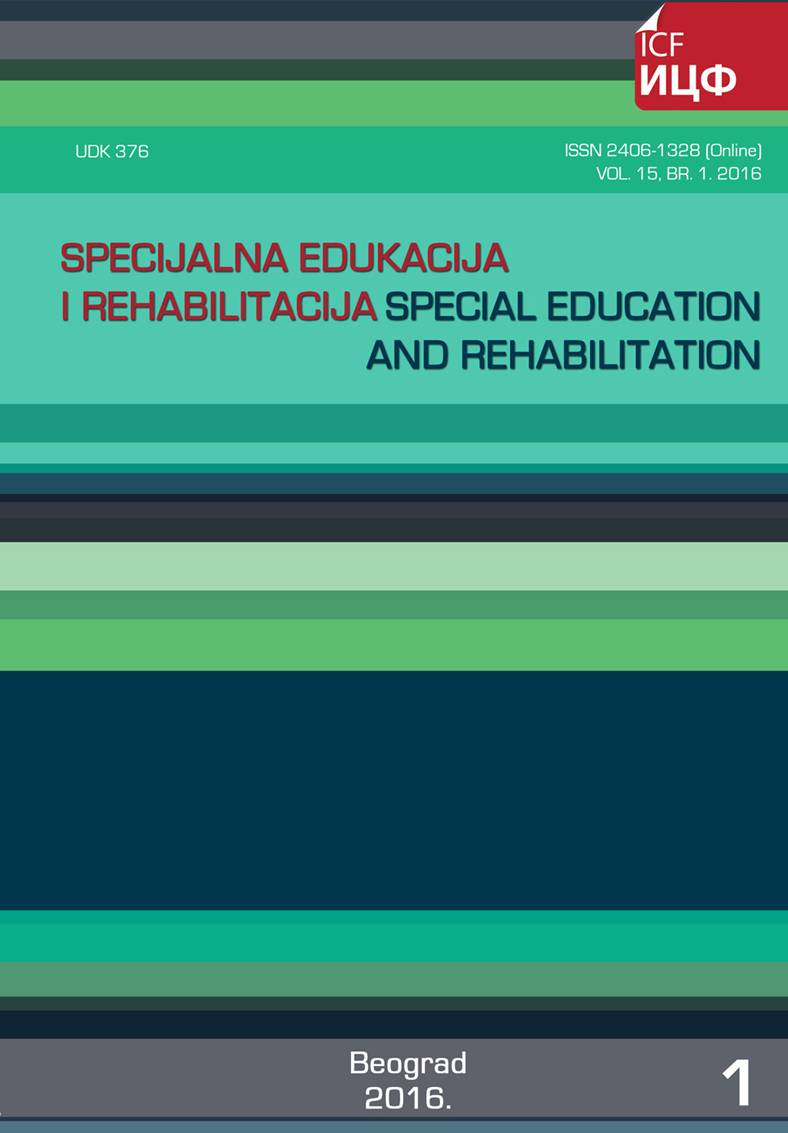NEKI ASPEKTI EGZEKUTIVNIH FUNKCIJA KAO PREDIKTORI RAZUMEVANJA TEKSTUALNIH MATEMATIČKIH ZADATAKA KOD UČENIKA SA LAKOM INTELEKTUALNOM OMETENOŠĆU
Sažetak
Pri rešavanju tekstualnih matematičkih zadataka najznačajniji segment rada odnosi se na tačno prevođenje sa matematičkog na maternji jezik u čijoj se osnovi, između ostalih faktora, nalaze otpornost na distrakcije i formiranje adekvatnih verbalnih strategija. Cilj istraživanja odnosi se na utvrđivanje doprinosa određenih aspekata egzekutivnih funkcija pri objašnjenju varijanse rešavanja tekstualnih matematičkih zadataka kod učenika s lakom intelektualnom ometenošću (LIO). Uzorak obuhvata devedesetoro učenika s LIO, kalendarskog uzrasta od 12 do 16 godina (AS=14,07; SD=1,46), oba pola (44,4% dečaka i 55,6% devojčica), bez neuroloških i višestrukih smetnji. Procena segmenata egzekutivnih funkcija realizovana je primenom Testa dvadeset pitanja i Stroop testom. U svrhu procene razumevanja matematičkog jezika primenjeni su verbalni problemski zadaci. Rezultati pokazuju da su procenjeni aspekti egzekutivnih funkcija značajni prediktori razumevanja matematičkog jezika kod učenika s LIO. Najjačim se prediktorom pokazala otpornost na distraktore (p=0,01).
Ključne reči: matematički jezik, verbalne strategije, otpornost na distraktore, laka intelektualna ometenost
Reference
Anobile, G., Stievano, P., & Burr, D. C. (2013). Visual sustained attention and numerosity sensitivity correlate with math achievement in children. Journal of Experimental Child Psychology, 116(2), 380-391.
Bull, R., & Scerif, G. (2001). Executive functioning as a predictor of children's mathematics ability: Inhibition, switching, and working memory. Developmental Neuropsychology, 19(3), 273-293.
Carpenter, P., Cobitt, K., Kepner, S., Linquist, M., & Reys, E. (1980). Solving verbal problems: Results and implications from national assessment. Arithmetic Teacher, 28(1), 8-12.
St Clair-Thompson, H., & Gathercole, S. E. (2006). Executive functions and achievements in school: Shifting, updating, inhibition and working memory. The Quarterly Journal of Experimental Psychology 59(4), 745-59.
Gold, A. B., Ewing-Cobbs, L., Cirino, P., Fuchs, L. S., Stuebing, K. K., & Fletcher, J. M. (2013). Cognitive and behavioral attention in children with math difficulties. Child neuropsychology, 19(4), 420-437.
Japundža-Milisavljević, M. (2008). Neuropsihološke funkcije i nastava matematike kod dece sa intelektualnom ometenošću. Pedagogija, LXIII(4), 666-673.
Klouda, G. V., & Cooper, W. E. (1990). Information search following damage to the frontal lobes. Psychological Reports, 67(2), 411-416.
Krstić, N. (1999). Osnove razvojne neuropsihologije. Beograd: Institut za mentalno zdravlje.
Mazzocco, M. M., & Kover, S. T. (2007). A longitudinal assessment of executive function skills and their association with math performance. Child neuropsychology, 13(1), 18-45.
Moreau, S., & Coquin‐Viennot, D. (2003). Comprehension of arithmetic word problems by fifth‐grade pupils: Representations and selection of information. British Journal of Educational Psychology, 73(1), 109-121.
Mueller, M., & Maher, C. (2009). Learning to reason in an informal math after-school program. Mathematics Education Research Journal, 21(3), 7-35.
Osaka, M., Nishizaki, Y., Komori, M., & Osaka, N. (2002). Effect of focus on verbal working memory: Critical role of the focus word in reading. Memory & cognition, 30(4), 562-571.
Salthouse, T. A., & Meinz, E. J. (1995). Aging, inhibition, working memory, and speed. The Journals of Gerontology Series B: Psychological Sciences and Social Sciences, 50(6), 297-306.
Sharma, M. C. (1996). Assessment of Mathematics Learning. Math Notebook, 10, 1-52.
Stein, M. K., Grover, B. W., & Henningsen, M. (1996). Building student capacity for mathematical thinking and reasoning: An analysis of mathematical tasks Used in Reform Classrooms. American Educational Research Journal, 33(2), 455-488.
Stern, E. (1993). What makes certain arithmetic word problems involving the comparison of sets so difficult for children? Journal of Educational Psychology, 85(1), 7-23.
Stroop, R. (1935). Studies of interference in serial verbal reactions. Journal of Experimental Psychology, 18, 643-662.
Toll, S. W., & Van Luit, J. E. (2012). Early numeracy intervention for low-performing kindergartners. Journal of Early Intervention, 34(4), 243-264.
Toll, S. W., & Van Luit, J. E. (2014). The developmental relationship between language and low early numeracy skills throughout kindergarten. Exceptional Children, 81(1), 64-78.
Toll, S. W., Van der Ven, S. H., Kroesbergen, E. H., & Van Luit, J. E. (2011). Executive functions as predictors of math learning disabilities. Journal of Learning Disabilities, 44(6), 521-532.
Upton, D., & Thompson, P. J. (1999). Twenty questions task and frontal lobe dysfunction. Archives of Clinical Neuropsychology, 14(2), 203-216.

